 Thank You David Frawley Tias and Srya Little Jeff Martens Tim Miller Darlene Tate and especially my wife, Margo, for her ever-present support and love. TABLE OF CONTENTS THE LANGUAGE OF YOGA SANA NAMES To access the audio files that accompany this book, visit SoundsTrue.com/store/TheLanguageofYoga and choose to either download the tracks to your computer or stream them on your reading device.
Thank You David Frawley Tias and Srya Little Jeff Martens Tim Miller Darlene Tate and especially my wife, Margo, for her ever-present support and love. TABLE OF CONTENTS THE LANGUAGE OF YOGA SANA NAMES To access the audio files that accompany this book, visit SoundsTrue.com/store/TheLanguageofYoga and choose to either download the tracks to your computer or stream them on your reading device.  INTRODUCTION Knowing how to properly pronounce Sanskrit is a crucial skill for serious students and teachers of yoga. This sacred language originated from oral traditions developed to communicate the spiritual insights of ancient sages. Because Sanskrit is the language of yoga, understanding key Sanskrit terminology and its pronunciation can deepen a practitioners knowledge of the yogic path. It can also provide a more complete understanding of the meaning and purpose of yoga sanas, or posturesan understanding that is lost when these sanas are known only by their English names.
INTRODUCTION Knowing how to properly pronounce Sanskrit is a crucial skill for serious students and teachers of yoga. This sacred language originated from oral traditions developed to communicate the spiritual insights of ancient sages. Because Sanskrit is the language of yoga, understanding key Sanskrit terminology and its pronunciation can deepen a practitioners knowledge of the yogic path. It can also provide a more complete understanding of the meaning and purpose of yoga sanas, or posturesan understanding that is lost when these sanas are known only by their English names.
Sanskrit is said to have been divinely revealed to meditating sages thousands of years ago. One story tells of iva beating his damaru drum fourteen times and creating the Sanskrit alphabet. These fourteen Mahevara Stras form the beginning of the text defining Sanskrit grammar. The alphabet is perfectly designed for the human vocal apparatus, and the sound of each word represents the subtle energy of its meaning. Because each syllable is either one or two beats, pronouncing correctly allows one to feel the natural rhythm of the language and imbibe the true essence of the word. Sanskrit is called Devavi or language of the Gods because it is said that the Gods understand and communicate in Sanskrit.
Thus, sacred ceremonies like births, weddings, deaths, and religious rituals all involve Sanskrit chanting. The sound of the Vedic hymns is their life, preserved by thousands of generations through chanting. Because Vedic wisdom was passed down orally long before it was written, no one knows when it actually began. The Vedas are the earliest known Sanskrit writings, beginning with the g Veda whose written form dates back to at least 1500 BCE. The subsequent three Vedas (Sma, Yajur, and Atharva) are all derived from the g Veda. The Upaniads, which form the basis for Vednta philosophy, are extrapolations and summaries of the Vedas.
Taken together, the Vedas and their offspring Upaniads are known as sruti, meaning heard, because they are considered to be of divine origin, originally revealed by enlightened seers. Yoga, along with yurveda (Indian medicine), Jyotia (Indian astrology), and countless other branches of Vedic wisdom, was passed down orally and literally using the refined Sanskrit language. Stras, terse aphorisms packed with information and easy to memorize, were often composed to record ideas in the most efficient way possible. Only with the help of a teacher and/or a commentary could a student learn the depth of their meaning. Verses were also written in rhythmic meters, most commonly four lines of either eight or eleven syllables each. Chanting or singing these verses provides another natural and easy way to remember them by heart.
Yoga in the West is often largely focused on practicing physical postures (sanas). However, sana is in fact only one of eight distinct limbs of yoga (see Aga). Knowing the posture names in Sanskrit allows teachers and students to unambiguously refer to a posture. Using the English translation as the reference may be confusing because translations can differthe same posture may have several different English names. In addition, fully comprehending all parts of an sana name can provide a deeper understanding of its form and function. Noticing how the same word is used in several different posture names will reveal subtle nuances that would otherwise be lost.
The Indian process of learning is largely based on viewing an object from a variety of angles, thus seeing it in its complete form. The purpose of this book is to preserve and encourage the correct sound and spelling of Sanskrit chants and terms related to the science of yoga. This provides a reference for yoga practitioners who wish to perpetuate the vocabulary of yoga in an accurate and respectful way. Seeing terms grouped together in logical arrangements allows one to visualize their relationship to each other. We hope your journey on the path of yoga will expand and brighten as you experience the audio and visual energy of this beautiful language. SANSKRIT PRONUNCIATION NOTES Vowel combining: In Sanskrit, when two vowels meet they will combine into something else.
For example, pacima uttnsana becomes pacimottnsana and marci sana becomes marcysana. Consonant combining: In Sanskrit, if the final consonant of one word is not sound-compatible with the initial consonant of the next word, the final consonant may change. For example, a mukh becomes anmukh, tiryac mukha becomes tiryamukha, and catur pda becomes catupda. Some Sanskrit sounds are pronounced slightly differently in North and South India. The v might sound like a w and the or may sound like a sh or a s. There are some differences between Sanskrit and Hindi pronunciation.
In Sanskrit, when a word ends with an a, the a is pronounced. In Hindi it is often dropped, even though it is written the same way. For example, the Sanskrit sana sounds like san in Hindi.
| SANSKRIT | HINDI |
|
| a at the end of a word is pronounced | a at the end of a word is often not pronounced |
| at the end of a word is long | at the end of a word is pronounced a short a |
| ph pronounced as an aspirated p | ph pronounced like f |
EXPLANATORY NOTES The images at the beginning of each section are the geometrical representations (
yantra) of each elemental
cakra. Each yantra conveys the energy that matches the associated cakra. The Sanskrit sound in the center of each yantra is that cakras primary sound, a single syllable ending in m.

If you cannot find the Sanskrit sana name in the AY section, look in the sana Name Synonyms index.
Use the English Name Index to locate the posture by English name. The line drawings are intended as a general representation of each posture. Some variations are not shown. Many postures have several different names, and one name may be used for many postures. The names included here are drawn from the classical systems of yoga and the teachings of B.K.S. Iyengar and T.K.V.
Desikachar. The first three series of K. Pattabhi Jois Aga system are given separately. Many Sanskrit terms are very complex and difficult to translate into English. Because of this, the suggested meanings are not meant to be definitive. I chose to provide the literal definition for most sana names.
For yoga terms whose common meaning is different than the literal, the literal meaning is shown in quotation marks. AGA SEQUENCES In Sanskrit the consonants are used to count variations of a posture. So ka=a, kha=b, ga=c, gha=d. Several postures are not specifically named in the series but are done as transitory postures. These are indicated with an asterisk*. Many teachers have modified the first series in different ways, usually adding or deleting postures.
The first series presented here is based on K. Pattabhi Jois own writing in Sanskrit. The second and third series are consistent and drawn from the knowledge of senior practitioners. The first and last postures (Samasthiti and Utpluti) are pronounced with an h on the end by most practitioners. Even though this is inconsistent with the remaining sana names (which are not pronounced with their ending m), out of respect for convention it remains that way here. Many names in the third series are different than in the AY section.
Next page
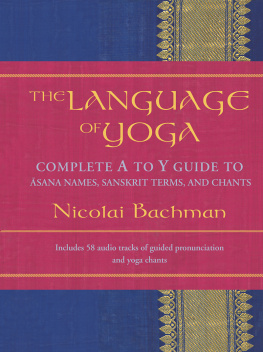




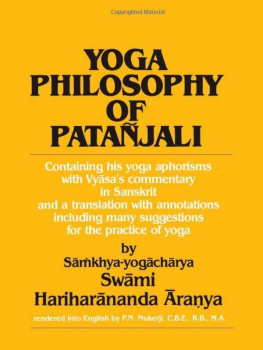

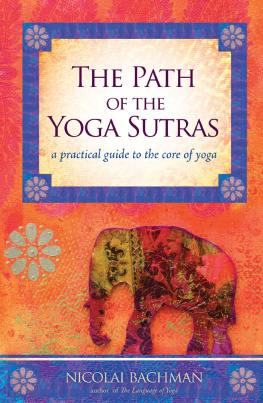
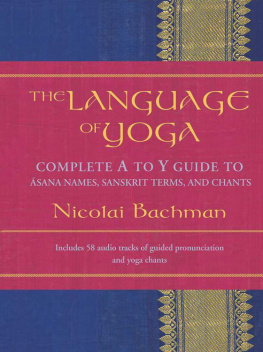

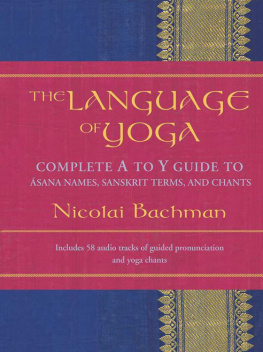
 Thank You David Frawley Tias and Srya Little Jeff Martens Tim Miller Darlene Tate and especially my wife, Margo, for her ever-present support and love. TABLE OF CONTENTS THE LANGUAGE OF YOGA SANA NAMES To access the audio files that accompany this book, visit SoundsTrue.com/store/TheLanguageofYoga and choose to either download the tracks to your computer or stream them on your reading device.
Thank You David Frawley Tias and Srya Little Jeff Martens Tim Miller Darlene Tate and especially my wife, Margo, for her ever-present support and love. TABLE OF CONTENTS THE LANGUAGE OF YOGA SANA NAMES To access the audio files that accompany this book, visit SoundsTrue.com/store/TheLanguageofYoga and choose to either download the tracks to your computer or stream them on your reading device.  INTRODUCTION Knowing how to properly pronounce Sanskrit is a crucial skill for serious students and teachers of yoga. This sacred language originated from oral traditions developed to communicate the spiritual insights of ancient sages. Because Sanskrit is the language of yoga, understanding key Sanskrit terminology and its pronunciation can deepen a practitioners knowledge of the yogic path. It can also provide a more complete understanding of the meaning and purpose of yoga sanas, or posturesan understanding that is lost when these sanas are known only by their English names.
INTRODUCTION Knowing how to properly pronounce Sanskrit is a crucial skill for serious students and teachers of yoga. This sacred language originated from oral traditions developed to communicate the spiritual insights of ancient sages. Because Sanskrit is the language of yoga, understanding key Sanskrit terminology and its pronunciation can deepen a practitioners knowledge of the yogic path. It can also provide a more complete understanding of the meaning and purpose of yoga sanas, or posturesan understanding that is lost when these sanas are known only by their English names. If you cannot find the Sanskrit sana name in the AY section, look in the sana Name Synonyms index.
If you cannot find the Sanskrit sana name in the AY section, look in the sana Name Synonyms index.